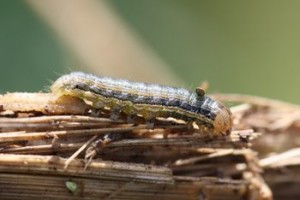UPDATE: Since my article last week (below), there have been a number of calls about armyworms in wheat. There have also been calls from corn. Be watchful of sorghum or corn fields adjacent to wheat or grassy weeds from which armyworms may migrate. High numbers of migrating large larvae can cut corn or sorghum plants down to size, and Bt corns are not immune to injury.
Armyworms in wheat make people nervous, but UT’s recommendations not to treat in wheat once it reaches the soft dough stage is based on research done several years ago in Arkansas. My counterpart, Dr. Gus Lorenz, is very confident in this recommendation. The only exception is when significant head cutting is also occurring. You can read Arkansas news article at the link below if it will ease your mind. It also provides some good tips related to scouting.
http://www.arkansas-crops.com/2014/05/12/true-armyworms-wheat/
——————————————————————————————
There have now been a few reports of true armyworm larvae being found in wheat, although nothing at threshold levels. As a reminder, treat for true armyworm when 6-8 larvae are present per square foot IF wheat is still in the milk stage. Once past the milk stage, wheat can tolerate higher populations and treatment is not usually recommended unless larvae are cutting wheat heads.
Most people use a pyrethroid insecticides such as Baythroid XL, Declare, Karate/Warrior or Mustang Max because these products are effective and relatively inexpensive. Identification is usually not a big problem as this is the only caterpillar likely to be found in wheat this time of year. Be advised that armyworms often drop to the ground when even mildly disturbed or if you cast a shadow on them. You must sample the ground beneath the wheat to get a good count.



I’m now getting some calls about higher numbers of armyworms, so pay special attention to any milky wheat and treat accordingly.